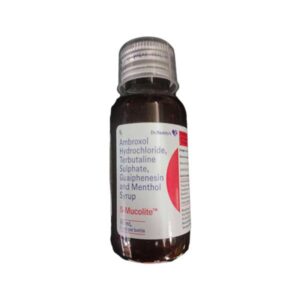AMBROXOL + SALBUTAMOL
Ambroxol: Ambroxol is a drug primarily used to treat respiratory conditions such as cough and bronchitis. It is categorized as a mucolytic agent and is commonly available in oral formulations such as syrup, tablets, and capsules.
The mechanism of action of Ambroxol involves increasing the production of respiratory tract fluid and reducing the viscosity of mucus. This helps in the clearance of mucus from the airways, making coughing more productive and relieving congestion.
The usual recommended dose of Ambroxol varies depending on the formulation and the age of the patient. For adults, the typical dose is 30 mg to 90 mg of the immediate-release tablets or capsules, taken three times a day. For children, the dose may vary based on their age and weight, and it is best to consult a healthcare professional for accurate dosing instructions.
While Ambroxol is generally well-tolerated, it may cause a few mild side effects. Common side effects include nausea, vomiting, stomach discomfort, diarrhea, and allergic reactions such as rash or itching. These side effects usually resolve on their own and are not typically severe. However, it is important to consult a doctor if any side effects persist or worsen.
It is worth noting that Ambroxol should be used with caution in patients with a history of gastric ulcers or those taking other medications that may interact with it. Women who are pregnant or breastfeeding should also consult their healthcare provider before using Ambroxol.
As with any medication, it is important to follow the prescribed dose and duration of treatment for Ambroxol to achieve the desired therapeutic effects and minimize the risk of side effects.
Salbutamol: Salbutamol, also known as albuterol, is a bronchodilator medication widely used to treat respiratory conditions such as asthma, chronic obstructive pulmonary disease (COPD), and bronchospasm. It belongs to a class of drugs known as beta-2 adrenergic agonists.
The mechanism of action of salbutamol involves binding to beta-2 adrenergic receptors in the smooth muscles of the airways. This binding activates enzymes that cause relaxation of the bronchial muscles, leading to the dilation of the airways and improved airflow. Salbutamol also has a mild anti-inflammatory effect on the airways.
Salbutamol can be administered as an inhaler, tablet, syrup, or intravenous injection. The dosage and frequency of use depend on the form of the medication, the severity of the condition, and individual patient factors. Inhalers are commonly used for quick relief during acute episodes, while tablets or syrups may be used for maintenance therapy.
The typical dosage for adults using an inhaler is 1 or 2 puffs (100-200 micrograms) every 4-6 hours as needed. For children, the dosage may vary and should be as prescribed by a healthcare professional. Tablets or syrups usually range from 2 to 4 mg three to four times a day. It is important to follow the prescribed dosage and directions provided by the healthcare provider.
Like any medication, salbutamol may cause side effects. Common side effects include mild tremors, headache, dizziness, and a racing heart rate. These effects are usually temporary and decrease with continued use. Rarely, salbutamol can cause more serious side effects such as allergic reactions, chest pain, irregular heartbeat, and high blood pressure. If any severe side effects occur, medical attention should be sought immediately.
It’s worth noting that salbutamol is a short-acting bronchodilator and should not be used as a substitute for long-term controller medications in the management of chronic respiratory conditions. It is important for patients to work with their healthcare provider to develop a comprehensive treatment plan that includes both rescue and maintenance medications.

